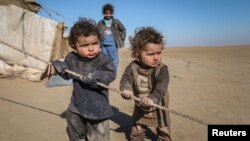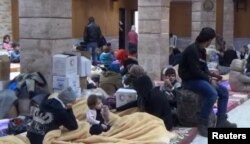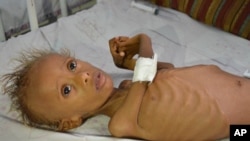Millions of children caught in conflict and other crises are at risk of dying from severe acute malnutrition if they do not receive life-saving therapeutic treatment.
This stark warning came as the U.N. children's fund launched a $3.3 billion-dollar appeal to provide life-saving assistance this year for 81 million people, more than half of them children, in 48 countries decimated by war, natural disasters or other humanitarian emergencies.
The largest amount of money, $1.4 billion, will go toward helping 17 million children and families caught up in war inside Syria and living as refugees in five neighboring countries: Turkey, Jordan, Lebanon, Iraq and Egypt. Half the beneficiaries are children.
Syria will enter its seventh year of war in March. Manuel Fontaine, director of emergency programs for the U.N. Children's Fund, said Syria is the largest humanitarian crisis facing the agency.
"Of particular concern is the situation of about 400,000 children who are actually in besieged areas," he said. "Unimpeded and sustained access is something we are asking for."
While praising the generosity of the five host countries, Fontaine noted that the situation of 2.8 million refugee children is extremely difficult because "in many cases, they are forced to work and are at risk of many protection threats.
"We estimate that in Jordan, for example, almost half of the Syrian refugee families have a child as a breadwinner. And, in Lebanon," he said, "three-quarters of the street children in the streets of Lebanese cities actually are Syrian refugees.
"Child marriage also is a major concern and on the increase concerning Syrian refugees," he added.
‘Silent threat’
The UNICEF appeal focuses particularly on the "silent threat" of malnutrition. An estimated 7.5 million children, it reports, will face severe acute malnutrition in most of the 48 countries in crisis, with the largest number and most serious cases in northeast Nigeria, Yemen, South Sudan and Somalia.
In war-ravaged northeast Nigeria, UNICEF plans to aid 4 million people, more than half of them children. In South Sudan, two-thirds of the 3.3 million beneficiaries are children.
Fontaine told VOA he is very worried about the situation in northeast Nigeria because dangers posed by Boko Haram insurgents make it difficult to reach people with aid.
"We are very close,” he said. “We have our supplies there. We have our people and we will try to find every occasion we can identify to move in and do our work."
He said similar difficulties also existed in South Sudan. "It is a real worry that war action and fighting actually just do not allow us, in some cases, to access children."
‘Challenges are huge’
UNICEF reports almost one in four of the world's children lives in a country affected by conflict or disaster; that in countries such as Syria, Yemen, Iraq, South Sudan, and Nigeria, children are under direct attack in their homes, schools and communities.
Meritxell Relano, UNICEF Yemen representative, described the situation for children in Yemen as catastrophic. She said at least 10 million children need some form of humanitarian assistance.
She said the war has displaced at least 3 million people, half of them children, food is scarce, and 60 percent of the population lives on less than $2 a day. She said the health system is on the verge of collapse, and severe acute malnutrition rates are soaring.
"Definitely, children are dying of malnutrition. That is for sure,” she said. “The children that are not being reached by us or by the programs that are treating severe acute malnutrition are dying.
"The under-five mortality rate has increased to the point that we estimate that, at least in 2016, 10,000 more children died of preventable diseases."
She noted that severe acute malnutrition is created by lack of food, lack of access to clean water and sanitation, lack of health services, and the rampant poverty in the country.
"This combination of factors is really increasing the malnutrition rate to the point that we have tripled the rate of severe acute malnutrition from 2014 to 2016,” she said. “It has gone from 160,000 to 462,000."
UNICEF said its appeal would provide a lifeline for tens of millions of children during the coming year by providing food, access to clean water and sanitation, health services education, and other essential services.
"The challenges are huge," Fontaine said, "but not insurmountable. ... In these difficult conditions of access, we are saving lives on a daily basis."









